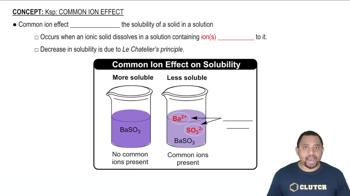Here are the essential concepts you must grasp in order to answer the question correctly.
Solubility Product Constant (Ksp)
The solubility product constant (Ksp) is an equilibrium constant that applies to the solubility of sparingly soluble ionic compounds. It represents the product of the molar concentrations of the ions, each raised to the power of their coefficients in the balanced dissolution equation. For Fe(OH)3, the Ksp value helps predict how changes in ion concentration, such as the addition of NaOH, will affect its solubility.
Recommended video:
Solubility Product Constant
Common Ion Effect
The common ion effect refers to the decrease in solubility of a salt when a common ion is added to the solution. In this case, adding NaOH introduces OH- ions, which are common to Fe(OH)3. This increase in hydroxide ion concentration shifts the dissolution equilibrium to the left, reducing the solubility of Fe(OH)3 due to Le Chatelier's principle.
Recommended video:
Net Ionic Equations
A net ionic equation represents the chemical species that are involved in a reaction, excluding spectator ions that do not participate. For the dissolution of Fe(OH)3 in the presence of NaOH, the net ionic equation will show the formation of Fe(OH)4- ions, highlighting the interaction between Fe(OH)3 and the added hydroxide ions. Writing this equation helps clarify the chemical changes occurring in the solution.
Recommended video:




